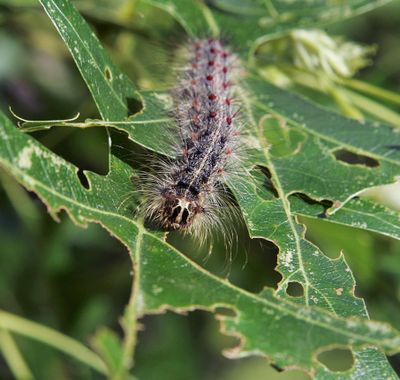Oregon proposes gypsy moth spraying; Washington may follow

SEATTLE – Oregon agriculture officials are proposing to spray about 8,000 acres over the Portland area next spring to kill leaf-eating gypsy moths.
Meanwhile, Washington state agriculture officials will decide soon whether to propose spraying a biological pesticide over 10,500 acres across seven sites in Western Washington, including Kent, Tacoma, Vancouver and Seattle’s dense Capitol Hill neighborhood.
Asian gypsy moths have yet to permanently establish in the U.S., and agriculture officials say they want to prevent the destructive insects from taking hold. Gypsy moths devour shrubs and trees and can make forests more vulnerable to other problems, leading to possible quarantines on Northwest agricultural products such as Christmas trees and raw timber.
“The gypsy moth is a serious invasive pest that can cause great damage to our state,” Washington’s Agriculture Director Derek Sandison told state senators at a hearing in Olympia last month.
Aerial spraying of a moth-killing insecticide has been controversial in the past. In 2000, a Washington state plan to spray over two Seattle neighborhoods brought out passionate opposition. A citizens group unsuccessfully sued in King County Superior Court to stop the aerial insecticide spraying.
In October, a panel of experts recommended that Oregon and Washington spray areas where Asian gypsy moths were detected in 2015. The group included federal and state agricultural officials, as well as experts from Canada, the University of Washington and the University of California, Riverside.
The Oregon Department of Agriculture trapped 14 gypsy moths last summer, including two Asian gypsy moths in the Portland area.
Last summer, Washington found 42 gypsy moths in six counties, including 10 of the Asian variety. Asian gypsy moths have not been found in the state since 1999. Unlike the European variety, they are considered more destructive because they can fly and spread more rapidly.
The panel also recommended spraying in Seattle’s Capitol Hill neighborhood, where 22 European gypsy moths were found.
Officials believe the pests arrived on ships from Asia, particularly from Far East Russia, as thousands of steel plates are imported from areas across the Pacific that are infested with Asian gypsy moth.
Oregon and Washington officials said they would do environmental assessments, reach out to stakeholders and get extensive public comment before finalizing any spraying plans.
The states would use a biological insecticide called bacillus thuringiensis kurstaki, commonly known as Btk, a bacterium found naturally in the soil. The pesticide is sprayed on foliage and kills the moths that eat the leaves or needles.
State officials say it is widely used, safe and effective and has been approved for use in organic farming.
Jim Marra, Washington’s pest program manager, told state senators last month that the pesticide has an excellent safety record and targets only moths and butterflies with a similar history life.
If Washington proceeds, it would conduct three aerial sprayings, seven to 10 days apart, in April 2016.
The Washington state Department of Health says on its website that the pesticide Btk is not toxic to humans and that a vast majority of people living in sprayed areas report no symptoms. Even so, the state agency recommends people in the spray area minimize their exposure.